Channa in general
Channa, commonly known as Snakeheads, are primitive predatory fish and members of the family Channidae. They are a group of perciform (perch-like) fishes whose affinities are unknown, although recent studies on the molecular phylogeny of bony fishes consider snakeheads as most closely related to the labyrinth fishes (anabantoids) and the synbranchiform eels, which include the spiny eels.
The Channa family includes 31 species widely distributed in Asia from southeastern Iran and eastern Afghanistan eastward through Pakistan, India, southern Nepal, Bangladesh, Myanmar, Thailand, Laos, Malaysia, Sumatra, Indonesia, Vietnam, Korea, and China to and with part of Siberia. In addition, 3 species of the related Parachanna family are found locally in parts of Africa.

De Channa soorten kennen grote verschillen in formaat. De onofficiële term Dwerg Slangekopvissen is door aquariumhouders bedacht om een groep van Channa soorten te duiden die niet groter worden dan 25 cm: Channa bleheri, Channa cachua, Channa orientalis, Channa andrao. Deze soorten zijn vanwege de beperkte omvang en het relatief vreedzame karakter ook het meest geschikt voor het houden in een aquarium.De meeste anders soorten worden maximaal 30-90 centimeter. Vijf soorten (Channa argus, Channa barca, Channa marulius, Channa micropeltes en Channa striata) kunnen zelfs 100 centimeter of groter worden en kunnen als monstervissen worden beschouwd die nauwelijks geschikt zijn voor het houden in een aquarium.
Origin
Fossiles dated from 50 million years ago indicate an origin in the southern Himalayas (India and East Pakistan). From 15 million years ago, the animals have spread by the expanding intertropical climate zone to parts of Europe, Africa, and larger parts of Asia.
Physical features
Channa have an elongated body and are distinguished by their long dorsal fins large mouths full of teeth. They earn their common name Snakehead because of their flattened shape and the scales on their heads that are reminiscent of the large epidermal scales on snakes.
Channa have gills to breathe water like most other fish. However, subadults and adults can also breathe air to supplement their demand for oxygen. Snakeheads are in fact obligatory air breathers and must have air from the surface otherwise they will drown. Unlike many other airbreathing fishes, Channa have a series of cavities in the rear section of their head. These suprabranchial chambers are filled with folded tissues that have a high surface area, and allow oxygen change to occur directly between air and their blood. Unlike mammals, they lack a diaphragm and use water to exchange old air with fresh air each time they take a breath. Thus, their ability to breathe air when out of the water is limited. They appear to breathe air more frequently when swimming actively.
The genera Parachanna (native to parts of Africa) is described apart from the genera Channa because of a more primitive implementation of the airbreathing section.
Snakeheads are known to migrate over short distances overland to find other water basins, using the ability to breathe air. When moving over land they curve their body in an S shape first, before launching themselves forward by a powerful stretch. In high humidity conditions, Channa are able to survive from 2 up to 4 days out of the water. When placed in direct sunlight, however, they desiccate and perish in minutes to several hours. In contrary to what is believed, Snakeheads are not known to leave the water for any reason other than making their way back to the water after flooding. The only snakeheads that actively leave the water belong to the dwarf species (C. gachau and C. orientalis, C. asiatica, and C. amphibius). Even then there is a clear reason for leaving the water, such as escaping overpopulation.
Snakeheads can be found in a wide variety of waters and water conditions. They are found in tropical, subtropical and temperate regions. Snakehead fish are not dependent on the oxygen level in the water. Many (not all) species can also tolerate widely varying temperatures and water parameters for a period of time. However, they are very vulnerable to sudden changes in water parameters.
Commercial interest
Snakeheads are important consumption fish, especially in India, Southeast Asia, China and to a lesser extent Africa. It has been fished on a large scale for centuries. In recent decades, certain species (C. maculata, P. obscura, C. striata, C. argus) have been cultivated for consumption. Sometimes they are used by fish farmers to reduce “pest fish” such as Tilapia.
In Southeast Asia, markets are often overrun with snakeheads. Fishermen and sellers take advantage of the fish’s ability to survive in just a thin film of water. This means that fresh fish can be offered throughout the day, a nice bonus in the not-always-hygienic conditions of a warm market.
Scientific research shows that snakeheads contain natural anti-inflammatories. In addition, it is known that they have a high content of omega-6 fatty acids, which have an analgesic effect. The fish oil also has positive effects on the prevention of cardiovascular disease and cancers.
“Fish out of hell”
Partly as a result of colonization, snakeheads have been deliberately introduced to other areas (Madagascar, Hawaii, Taiwan, Japan, Kazakhstan, Turkmenistan, Uzbekistan, and the Czech Republic) over the past hundred years. Today, snakeheads are considered a major threat to local ecosystems. Especially in the absence of natural enemies (such as humans), they are very invasive and destructive. Large species become sexually mature after 2-3 years, mate up to 2-5 times a year, and produce up to 15,000 eggs at a time. In addition, they are considered capable of migrating overland to other water systems. C. argus in particular is thought to be able to double its population within 15 months.
The discovery of a number of species of snakeheads in US waters has caused quite a stir. The media has been used to take unpopular measures to prevent the further spread of the species (such as draining or completely poisoning). Various media created a Piranha-esque image of a monster fish that eats an entire lake, then moves overland to the next lake, preying on dogs and children along the way. National Geographic came out with a slightly more fact-based documentary Invasion of the Snakeheads that talked about Fishzilla. Filmmakers in Hollywood found inspiration and support for 2 horror films in the hype.
Asian food markets (and the related need to store live fish in natural fish ponds) were blamed for the invasion. With the availability as food fish, the fish also became available to aquarium and pond keepers. Fish that grew too big for the tank often ended up in the local ecosystem. Since 2002, many US states have banned the possession of live snakeheads. In Europe, too, an import permit is required for C. argus, because this species is able to thrive in our colder waters.
Behavior
Snakehead fish are predatory fish that feed on plankton, insects and snails as youngsters. As they grow larger, the larger species switch to a menu consisting mainly of fish, frogs, crabs, shrimps, small aquatic mammals and waterfowl. Young specimens usually hunt in groups. When they reach sexual maturity, they isolate themselves to lead a solitary life or live in pairs. They then develop a higher degree of aggression towards conspecifics and often also towards other fish. Often a couple will not tolerate other fish in the limited space of an aquarium.
Snakeheads are not active swimmers. In addition to hunting, they actively move only to draw air from the surface. Usually, they swim in the middle water layer or rest on the bottom to strike from an ambush. A number of species, however, are pelagic and are more active swimmers. All snakeheads are capable of launching themselves forward from a standstill by briefly curving their muscular body and stretching it forcefully.
Brood care is an important behavioral trait for Snakeheads. All species violently guard and defend their eggs and young. The majority of species lay eggs that rise to the surface and are guarded there. A number of smaller species collect these eggs and store them in a burrow that may or may not have been dug. A number of species are mouthbrooders.
The snakehead is a popular – eccentric – fish among a specialist group of aquarium keepers. Snakeheads are elegant, powerful, alert, and calm fish, with a willful character. The mutual communication, hunting technique and brood care is fascinating. Some aquarium keepers specialize in keeping the largest species and have a pet-like experience. Some rare and variegated species (such as C. barca) are among the most valuable aquarium fish on the market.
Snakeheads often have changing patterns and colors as they grow. With the exception of the dwarf species, the young of most species are much more beautifully marked and colored than the aging fish. With age, they usually get a duller ground color. Some aquarium keepers lose interest in them as they grow. It is therefore wise to do some research before purchasing.
As predators, snakeheads are by nature not a suitable choice for the average community aquarium. They are intolerant and usually soon the only fish. A special aquarium is required for keeping snakeheads. Aquarium keepers have different experiences when it comes to mixing snakeheads with other tankmates. Most species are best kept alone. Combining snakeheads with territorial or aggressive tankmates is not recommended. An intimidated snakehead fish hides, tries to escape and refuses to eat.
The extent to which other fish are tolerated in the small habitat of an aquarium depends very much on the species, but within that probably also on the individual specimen and the specific situation. There are a number of general experiences per group:
Dwarf species
Due to their small size and relatively mild temperament, most dwarf species pair well with robust, fast fish of a similar size. Provided these fish are not too territorial or aggressive. It should be taken into account that most dwarf snakeheads live in their natural environment in an eco climate zone with seasonal extremes in water temperature and water values. As a result, they cannot be kept at a tropical temperature all year round. A temperature reduction for at least one season per year is necessary to keep them healthy. Co-residents must also be able to cope with this.
Medium sized species
This group contains the most diversity in terms of behavior. Many of the larger species (between 30-60 cm) can be combined with relatively fast and robust fish of a similar size, for example, large cyprinids. General experience is that combining with other fish species works best when the snakehead fish are not yet too big and when the other fish have already settled. Newly introduced fish are often killed immediately. It varies greatly by species and experience. Often the tolerance to other fish is temporary. When a pair of snakeheads is formed, the co-inhabitants (also conspecifics) are usually chased and killed.
Large species (60 – 130 cm)
These snakeheads themselves require an amount of space that most private aquariums are unlikely to be able to provide. Extremely large private aquariums are usually just big enough to hold one fish or a couple. In general, the same applies as with the medium varieties. Fish that grow with them from an early age are often tolerated. Newly introduced fellow residents are often killed immediately.
A number of large species, such as C. argus and C. micropeltes, are important food fish. They are considered highly invasive and destructive to the local ecosystem outside their natural habitat (see also the documentary Invasion of the Snakeheads). After the fish were sighted in several places in the US, import bans and a ban on owning a live specimen are in effect in most states within the US.
Channa bankanensis – Bangka Snakehead
Channa Bankanensis is a small snakehead. Channa Bankanensis is found in parts of Indonesia and Malaysia: Sumatra, Bangka island, South and West Kalimanten and wetlands around Selangor in Malaysia.
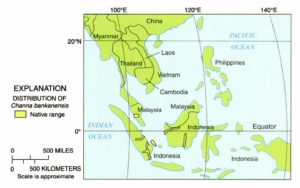
There are populations of this species that do not grow larger than 14 cm, and populations that grow to a maximum of 30 cm. This species grows significantly slower than other snakeheads.
The difference between males and females is hard to see. The females grow more slowly than males. It is a strictly tropical species that lives continuously in extreme conditions with almost stagnant, very soft water (pH between 2.8 and 3.8), and a temperature of 26-30 degrees Celsius.
It is best to keep this species as a couple or solitary. To form a couple, as with almost all snakehead fish, it is best to purchase a group of young fish. When a couple has been formed, the other fish must be caught (otherwise they will be killed). Keeping a group of this species requires a fairly large aquarium, lots of hiding places and luck. Experience with this species is that they are extremely intolerant of conspecifics and that they can cause great damage to each other in confrontations. Only when a couple has been formed do the confrontations between those individuals stop.
In principle, the species can be kept with other robust fish of at least 2/3 of its own body size. However, few fish can be kept in the soft water this species needs.
The Aquarium
An aquarium with densely planted areas, open swimming areas, sufficient hiding places, and not too bright lighting. Floating plants contribute to the fish’s comfort. Some darker spots are appreciated. Make sure that it is possible for them to get air from the surface, otherwise, they will suffocate. Close the aquarium tightly. They manage to escape from the aquarium through the smallest hole. This species only thrives in very soft water.
Diet
Carnivore. All common fish food is eaten, including frozen. They will not feed on dry food like flakes or granules.
Breeding Channa Bankanensis
Nothing is known about the cultivation of Channa Bankanensis. They are mouth brooders.
Video
Author
Patrick de Pijper
Copyright images
J. de Lange
AquariumGlaser.de
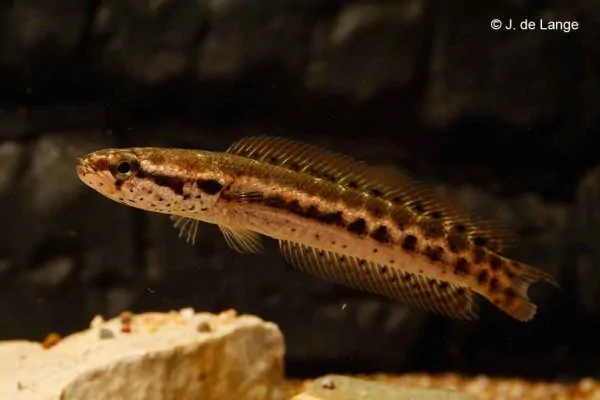







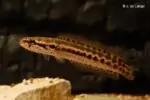

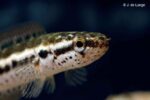
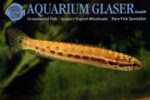




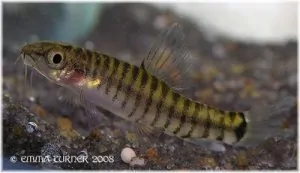


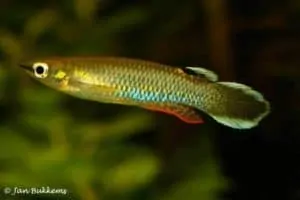
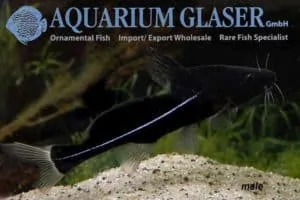


Reviews
There are no reviews yet.